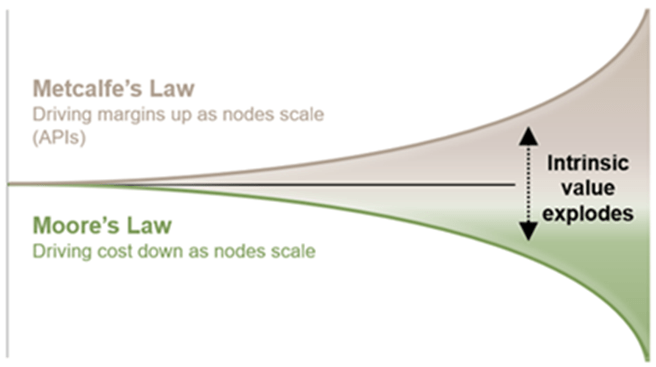GAM Investments’ Kevin Kruczynski explores how companies and organisations are increasingly embracing digitisation and the benefits it can offer, particularly in an inflationary environment.
16 August 2022
Click here to view the Disruptive Strategist newsletter in full.
As Satya Nadella, Executive Chairman and CEO of Microsoft, reminded us so succinctly on the last Microsoft earnings call, “Digital technology is a deflationary force in an inflationary economy. Business small and large can improve productivity and the affordability of their products and services by building tech intensity.”
Inflation is a hot topic as we are seeing some of the factors that have suppressed it for many years start to unwind. Several decades of relentless globalisation have led to elongated supply chains and lower production costs, but this began to reverse with the emergence of tensions between major economies, as well as the Covid disruption to trade flows. Similarly, the low commodity price environment which had been fuelled by previous periods of excess investment is also reaching an end as miners and oil companies have listened to their shareholders and are now prioritising capital returns over investment in capacity. This has left very little slack in the system for periods influenced by exogenous events, such as pandemics or wars. In this environment, technological innovation has a vital role to play in helping to enhance productivity, minimise wastage and keep costs down.
We often refer to Moore’s Law, which states that the number of transistors in a dense integrated circuit double every two years, and Metcalfe’s Law, which states that the usefulness of a network expands exponentially with every new user, and the influence these have had on lowering compute cost and unleashing a wave of disruptive innovation around the world.

Tech’s virtuous circle

With this backdrop in mind, we would like to highlight some examples of where we are seeing disruption help to ease cost pressures across an array of sectors.
Many healthcare systems in the US have been affected by staff shortages. Omnicell has seen an increase in demand for its pharmacy automation solutions, which help free up nurses’ and pharmacists’ time for other tasks. Its IV automation system leads to quicker and more accurate dispensing and helps lower costs by approximately 66% – one hospital in the US is saving USD 2.5 million each year by using this solution. Intuitive Surgical’s DaVinci Robots allow for less invasive procedures which significantly speeds up recovery, reducing the length of hospital stay. After a robotic assisted prostatectomy, a patient would be expected to leave the hospital within one to two days, whereas for open surgery, it would be three to seven days, thereby freeing up significant bed space and resource in already understaffed wards.
Across the industrial landscape, computer software and services firm PTC helps customers such as Bosch Group and Volvo with their digital transitions, using their leading computer-aided design (CAD), product lifecycle management (PLM), internet of things (IoT) and augmented reality (AR) products to streamline processes, minimise waste and drive efficiencies. The impact varies by solution, but for example, its ThingWorx connected work cell helps manage the flow of information across processes, and generally increases worker productivity by up to 40%, reduces waste by 25%, and lowers training time by up to 65%.
Agriculture and construction are both fragmented and labour-intensive industries that have been slow to adopt technology, but this is changing as worker shortages and high prices of input materials are encouraging companies to consider new solutions. Trimble serves both industries: its connected farm platform assists in optimising agricultural workflows, helping farmers to improve the performance and profitability of their crops. The technology maximises crop yields by providing data on soil conditions and helps plan efficient seed planting, as well as being able to view yields in real-time. Its technology is also used to steer and control tractors remotely and provides precise spraying and irrigation from machinery. For a highly detailed construction project, such as a bridge or airport, Trimble can build an exact digital replica of a modelled original with pinpoint accuracy, guiding heavy machinery with precision. This improvement in accuracy can generate millions of dollars in savings from avoiding project cost overruns, reworks and reducing the overall delivery time.
Other sectors such as transport, fast food restaurants and coffee chains have used cloud based mobile apps, self-service ordering technology and advances on the payments landscape to reduce the need for customer facing staff and cultivate customer loyalty through ease of use and rewards. Starbucks was an early pioneer with its mobile app, then McDonald's followed with its self-service ordering points, and in the UK, the London Underground has removed the need for ticket offices by adopting contactless card technology. All these solutions lower the need for staff and make the customer experience easier and less time consuming.
It is clear that embracing digitisation is getting cheaper and easier, and the benefits are even more apparent in an inflationary environment.
The information in this document is given for information purposes only and does not qualify as investment advice. Opinions and assessments contained in this document may change and reflect the point of view of GAM in the current economic environment. No liability shall be accepted for the accuracy and completeness of the information. Past performance is not a reliable indicator of future results or current or future trends. The mentioned financial instruments are provided for illustrative purposes only and shall not be considered as a direct offering, investment recommendation or investment advice. The securities listed were selected from the universe of securities covered by the portfolio managers to assist the reader in better understanding the themes presented and are not necessarily held by any portfolio or represent any recommendations by the portfolio managers. There is no guarantee that forecasts will be realised.
